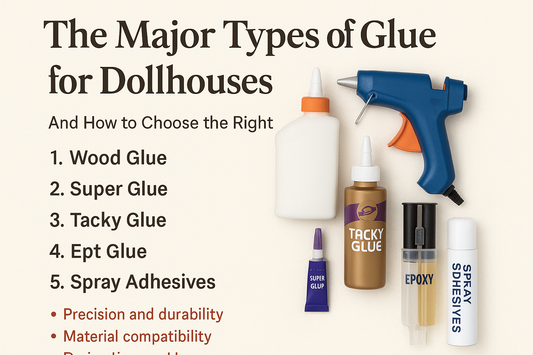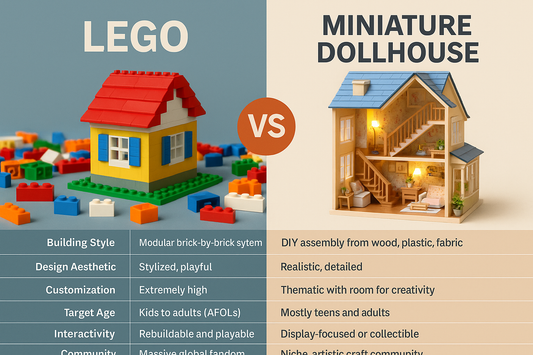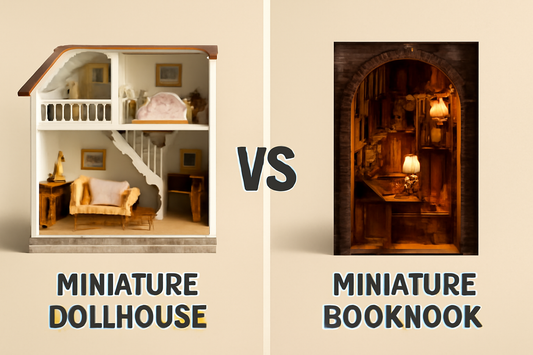
How to Choose the Best Dollhouse for Kids: Wooden vs. Plastic vs. DIY Kits
Share
Choosing the best dollhouse for your child can feel like a daunting task, especially with so many options available on the market. Whether you're looking for a traditional wooden house, a colorful plastic model, or a creative DIY kit, each type offers unique benefits that can contribute to your child’s development and provide hours of imaginative play. In this guide, we’ll explore the pros and cons of wooden, plastic, and DIY dollhouses to help you make the best choice for your child.
Wooden Dollhouses: Durability Meets Educational Value
Why Choose Wooden Dollhouses?
Wooden dollhouses have been a staple in children’s toys for decades, and for good reason. These classic toys are not only aesthetically pleasing but also offer a host of developmental benefits. Here are some reasons why wooden dollhouses might be the right choice for your child:
-
Durability: Wooden dollhouses are built to last, with sturdy construction that can withstand years of play. Unlike plastic dollhouses, which may break or crack, wooden models are often passed down through generations, making them an investment that can last.
-
Tactile Experience: The natural texture of wood offers a more sensory experience. Kids can engage in fine motor skills by arranging miniature furniture or moving tiny dolls around the house. This tactile interaction helps improve their dexterity.
-
Eco-Friendly Materials: Many wooden dollhouses are made from sustainable materials, which is a huge plus for environmentally conscious families. Some brands even use FSC-certified wood, ensuring the materials come from responsibly managed forests.
-
Educational Value: Wooden dollhouses encourage imaginative play and help children develop social and emotional skills. They can create their own stories and role-play different situations, which boosts creativity, empathy, and problem-solving.
Cons of Wooden Dollhouses:
-
Weight: Wooden dollhouses can be heavier than plastic ones, making them harder to move around or transport.
-
Cost: High-quality wooden models tend to be more expensive than plastic versions, although they can be a good long-term investment.
Plastic Dollhouses: Lightweight and Affordable
Why Choose Plastic Dollhouses?
Plastic dollhouses are an affordable, lightweight alternative to wooden models, and they’re ideal for families on a budget or those looking for a toy that’s easy to move and clean. Here are some benefits of plastic dollhouses:
-
Lightweight and Portable: Plastic dollhouses are much lighter than their wooden counterparts, making them easier for young children to handle and move around. If you’re looking for a portable toy that can be taken on trips or to different play areas, a plastic dollhouse might be a better option.
-
Affordability: Plastic dollhouses are generally more affordable, making them accessible to a broader range of families. If you're looking for a budget-friendly option, plastic is often the way to go.
-
Variety of Designs and Themes: Plastic dollhouses often come in a wider variety of themes and bright colors. Whether your child dreams of a princess castle, a space station, or a futuristic city, you’ll likely find a plastic dollhouse that matches their interests.
-
Easy to Clean: Since plastic is smooth and non-porous, it’s easier to clean than wood, which is important for maintaining hygiene after frequent play.
Cons of Plastic Dollhouses:
-
Durability: Plastic can crack or break more easily than wood, especially with rough handling.
-
Environmental Concerns: Many plastic dollhouses are made from non-recyclable materials, which could be a drawback for families seeking eco-friendly options.
DIY Dollhouse Kits: Spark Creativity and Learning
Why Choose DIY Dollhouse Kits?
If your child loves hands-on activities, a DIY dollhouse kit might be the perfect choice. These kits allow kids to build their dollhouses from scratch, fostering creativity, patience, and problem-solving skills. Here’s why you should consider a DIY kit:
-
Hands-On Creativity: A DIY dollhouse kit lets your child be part of the creative process. They can help assemble the house, choose the furniture, and decorate the rooms. This hands-on activity fosters critical thinking, spatial awareness, and fine motor skills.
-
Customizable and Personalizable: DIY kits give children the chance to create a personalized home. Whether they’re designing the layout of each room or choosing colors and themes, the possibilities for customization are endless.
-
Bonding Experience: Building a dollhouse together can be a fun family activity. It’s an opportunity for parents and children to collaborate on something special, enhancing the bond between them.
Top DIY Dollhouse Kits:
Look for 3D DIY wooden dollhouse kits, which often come with detailed instructions and pre-cut materials. These kits can range from simple models for younger children to intricate houses with mini furniture and accessories for older kids.
Cons of DIY Dollhouse Kits:
-
Time-Consuming: DIY kits require time and patience, which may be a challenge for younger children or parents with busy schedules.
-
Difficulty Level: Some kits may be too complex for young children to complete on their own. Make sure to choose a kit appropriate for your child’s age and skill level.
How to Make the Right Choice for Your Child
When deciding between wooden, plastic, and DIY dollhouses, consider these factors:
-
Age of the Child: Younger children may benefit from a plastic dollhouse that’s easy to move and clean, while older kids may appreciate the challenge of a DIY kit or the durability of a wooden house.
-
Budget: Wooden dollhouses tend to be more expensive but are built to last, while plastic dollhouses are more affordable upfront.
-
Interest and Preferences: Does your child love creating and customizing? A DIY kit may be the best fit. Are they more interested in the sensory experience of wood or the bright, fun colors of plastic? Choose accordingly.
-
Safety and Durability: Always check for safety certifications, especially for younger children. Look for non-toxic materials, secure parts, and age-appropriate designs.
Conclusion: Which Dollhouse is Right for Your Family?
The best dollhouse for your child ultimately depends on your family’s needs, preferences, and budget. Wooden dollhouses offer long-lasting durability and eco-friendly materials, plastic ones are lightweight and affordable, and DIY kits encourage creativity and hands-on learning.
No matter which type you choose, a dollhouse is an excellent investment that can provide hours of imaginative play and developmental benefits for your child. By understanding the unique benefits of each option, you can make an informed decision that fits your family’s lifestyle.
Looking for the perfect dollhouse? Check out our collection of beautifully crafted wooden dollhouses at Joyful Memo, where creativity meets quality!



